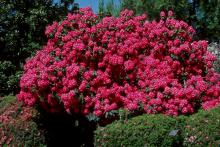- Broadleaf evergreen shrub, 8 ft (2.1 m), in time to 25 ft (7.6 m). Leaves medium to large, ca. 16 x 6.5 cm, flat, oblong elliptic to slightly obovate, rounded apex. Flowers red-pink, funnel-shaped, ribbed, about 7.5 cm wide, dark blotch mostly on middle lobe, stamens and filament pink, up to 24 flowers in a conical cluster.
- -15°F, middle, 4/3/4 [flower / plant & foliage / performance; scale 1 (poor) - 5 (best)]. Sun and heat tolerant. Grows openly in shade and compactly in sun. An old favorite, introduced before 1870.
-
The 'Cynthia' Story: In 1807, a Scottish botanist, John Fraser (1750-1811) and his son, John Jr., were the first Europeans to discover the rhododendron, R. catawbiense, a species which grows wild in North Carolina and Virginia. They sent plants back to England in 1809 and soon nurserymen and gardeners there hybridizing and experimenting with it. The species has been shown useful in increasing the winter hardiness of breeding lines. Thirty-nine years later, in 1848, the English plant explorer, Joseph Dalton Hooker, sent seeds of twenty-six species of Himalayan rhododendron to his father, Sir William Jackson Hooker, the Director of Kew Gardens. His son had collected the seeds in Sikkim, a mountainous state in northeastern India. Included in the list of species was the white-flowered R. griffithianum, of which some plantsmen think was the best of the lot.
Seeds of the Himalayan rhododendrons were distributed to nurseries, including the recently established Sunningdale Nursery owned by John Standish and Charles Noble. The Sunningdale Nursery catalog of 1858 offered the species R. griffithianum for sale. The next year the owners parted company with Standish starting a new nursery some 3 miles west of Sunningdale. In 1860 both Standish and Nobel introduced a R. catawbiense × R. griffithianum hybrid, its rose-pink, funnel-shaped flowers were over 3 inches wide and with as many as 24 flowers in a conical cluster. One authority (Clive Justice) stated that Nobel called the new hybrid 'Cynthia', whereas Standish named it 'Lord Palmerston'. Another authority (W.J. Bean) states that Nobel exhibited the hybrid under the name ‘Lord Palmerston’. In any case ‘Cynthia’ won out, but it was slow to gain recognition. However, in the early decades of the 1900s its popularity was second only to ‘Pink Pearl’. Apparently ‘Cynthia’ was also slow to gain recognition in the Royal Horticulture Society, for it was only in1993, some 133 years after it was introduced, that ‘Cynthia’ received the Society’s Award of Garden Merit.
- Oregon State Univ. campus: west of Gilkey Hall; also 2731 Arnold Way
- Corvallis: north side Central Park





